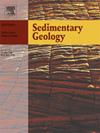Rapid subsidence as a driver of phosphate deposition in the later Ordovician: Case study from the Alabama Appalachians
IF 2.9
2区 地球科学
Q1 GEOLOGY
引用次数: 0
Abstract
An increase in accumulation of phosphate-enriched sediment occurred in several areas of Earth's oceans during the later Ordovician, suggesting that some fundamental change (s) in seawater and/or pore water chemistry were taking place, either syndepositionally or during early diagenesis. One hypothesis is that widespread cooling of the water column led to this increase, but another is that the increase could have been forced primarily by changes in seawater chemistry that accompanied an influx of siliciclastic sediments associated with tectonically driven subsidence. Here, we report on findings from study of the upper ~30 m of the >200 m of Middle and Late Ordovician strata exposed near Tidwell Hollow, Blount County, Alabama, and what the results suggest about the competing hypotheses. This Ordovician sequence, deposited along the southeastern margin of Laurentia during the initial (Blountian) stage of the Taconic Orogeny, records the transition from a restricted peritidal carbonate shelf environment (the “Black River lithofacies”) into a more normal marine carbonate environment (the “Trenton lithofacies”). In particular, the younger carbonate strata are notable for their measurably higher amounts of secondary phosphate minerals. This stratigraphic interval is also well-constrained chronostratigraphically by the presence of the Deicke and Millbrig K-bentonite beds (altered volcanic tephra layers), thus it is ideal for a focused geochemical, petrographic, and stratigraphic investigation of the increased phosphate content of a specific Upper Ordovician sequence. Analyses of bulk rock samples and of extracted collophane grains (via x-ray fluorescence, XRF, and in-situ laser ablation inductively coupled plasma mass spectrometer, ICPMS) suggest that phosphogenesis in these strata was episodic rather than slow and steady, with a depositional pattern of abrupt increases followed by abrupt declines. Observed trace element changes in the 12 m to 18 m sample interval include the occurrence of elevated Th/U ratios (maximum of 5.7) accompanied by Y/Ho ratios that range from 27 (base) to 51 (top). We attribute these changes to increasing silicate influx into the basin and an accompanying increase in available Fe, which would preferentially scavenge MREEs and then release them to the pore waters leading to MREE enrichment, which we also observe in this interval. In a rapidly subsiding basin, MREE enrichment could have resulted from initial restriction of bottom water circulation followed by gradually more open marine conditions. Some allochems and textures that are more characteristic of the older Black River lithofacies than the younger Trenton lithofacies (e.g. framework grains of calcareous green algae and Type 1 and Type 2 oncoids, fenestral lime mudstones, and associated small framestones of Tetradium sp. buildups) persist in relative abundance upsection into the ~10 m interval of strata above the Millbrig K-bentonite Bed, and this persistence supports the hypothesis that the Trenton transgression was not initially accompanied by widespread cooling of the Laurentian epicontinental sea. Instead, we propose that variable weathering rates, turbidity, and nutrient supply accompanied by relatively rapid subsidence could have governed the observed variability in phosphate deposition and elemental abundances in these sediments, and that this subsidence of the Laurentian margin could have been the driver of an uptick in phosphate deposition during the later Ordovician here, and perhaps at other locations as well where subsidence was occurring, given that increased phosphate deposition is a globally recognized and globally significant change in many Upper Ordovician sequences beyond eastern Laurentia.
奥陶世晚期快速沉降对磷酸盐沉积的驱动作用:以阿拉巴马阿巴拉契亚地区为例
在晚奥陶世,地球海洋的一些地区发生了富磷酸盐沉积的增加,这表明海水和/或孔隙水化学发生了一些根本性的变化,无论是在同沉积时期还是在早期成岩作用时期。一种假设是水柱的广泛冷却导致了这种增加,但另一种假设是,这种增加可能主要是由海水化学变化所强迫的,这种变化伴随着与构造驱动的下沉相关的硅质沉积物的涌入。本文报道了在美国阿拉巴马州布朗特县(Blount County)的Tidwell Hollow附近暴露的中奥陶世和晚奥陶世200米地层的上30米的研究结果,以及这些结果对相互矛盾的假设的建议。该奥陶系层序沉积于塔尼克造山初期(布朗田)沿劳伦提亚东南缘,记录了局限潮外碳酸盐岩陆架环境(“黑河岩相”)向较为正常的海相碳酸盐岩环境(“特伦顿岩相”)的转变。特别是较年轻的碳酸盐岩地层,其次生磷矿物的含量明显较高。由于Deicke和Millbrig k -膨润土层(蚀变火山泥层)的存在,该地层间隔在年代地层上也受到了很好的限制,因此,对于特定上奥陶统层序中增加的磷酸盐含量进行集中的地球化学、岩石学和地层学研究是理想的。通过x射线荧光、XRF和原位激光烧蚀电感耦合等离子体质谱仪(ICPMS)对大量岩石样品和提取的胶磷矿颗粒的分析表明,这些地层中的磷矿形成是间歇性的,而不是缓慢稳定的,具有突然增加然后突然下降的沉积模式。观测到的12 ~ 18 m样品段微量元素变化包括Th/U比值升高(最大值为5.7),Y/Ho比值从27(底部)到51(顶部)不等。我们将这些变化归因于流入盆地的硅酸盐的增加,以及伴随而来的有效铁的增加,这将优先清除MREE,然后将其释放到孔隙水中,导致MREE富集,我们在该层段也观察到了这一点。在快速沉降的盆地中,MREE富集可能是由于底部水循环最初受到限制,随后海洋条件逐渐开放。与较年轻的特伦顿岩相相比,一些更具有古黑河岩相特征的异化学和结构(如钙质绿藻骨架颗粒和1型和2型石粒、窗状灰岩泥岩以及与之相关的四合体小框架岩)在米尔布里格k -膨润土层上方约10 m的地层中仍然相对丰富。这种持续性支持了特伦顿海侵最初并没有伴随着劳伦森陆表海的广泛冷却的假设。相反,我们提出,变化的风化速率、浊度和营养供应伴随着相对快速的沉降,可能控制了这些沉积物中磷酸盐沉积和元素丰度的变化,并且劳伦森边缘的沉降可能是奥陶纪晚期磷酸盐沉积上升的驱动因素,也许在其他下沉发生的地方也是如此。考虑到在Laurentia东部以外的许多上奥陶统层序中,磷酸盐沉积的增加是全球公认的、具有全球意义的变化。
本文章由计算机程序翻译,如有差异,请以英文原文为准。
求助全文
约1分钟内获得全文
求助全文
来源期刊

Sedimentary Geology
地学-地质学
CiteScore
5.10
自引率
7.10%
发文量
133
审稿时长
32 days
期刊介绍:
Sedimentary Geology is a journal that rapidly publishes high quality, original research and review papers that cover all aspects of sediments and sedimentary rocks at all spatial and temporal scales. Submitted papers must make a significant contribution to the field of study and must place the research in a broad context, so that it is of interest to the diverse, international readership of the journal. Papers that are largely descriptive in nature, of limited scope or local geographical significance, or based on limited data will not be considered for publication.
 求助内容:
求助内容: 应助结果提醒方式:
应助结果提醒方式:


